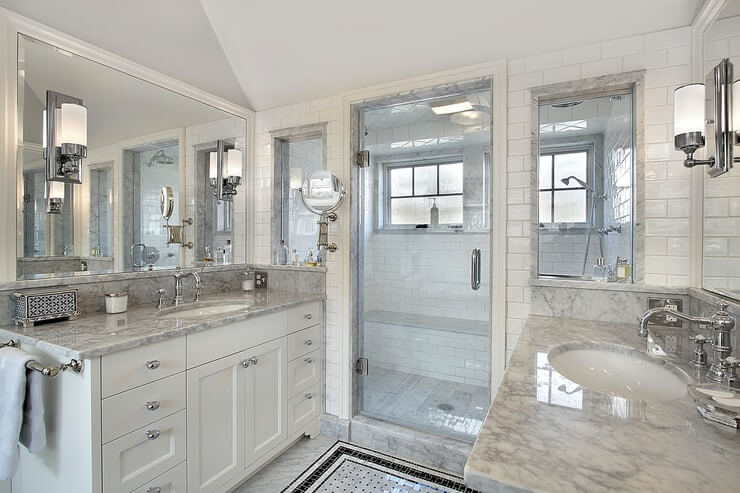Torn between keeping the tub or embracing a master bathroom without one?
This question is becoming increasingly relevant as more adults prefer the convenience of quick showers over leisurely baths.
Discover the benefits and innovative design ideas, and consider the essential factors before removing a bathtub from your master bathroom.

Do I Need a Bathtub in My Master Bathroom?
Bathtubs are not mandatory parts of bathrooms.
The need for a bathtub will depend on your bathing preferences.
Many modern bathrooms use just a shower that has a shower pan with a slight lip and a shower curtain or a walk-in with a glass shower enclosure to keep water inside.
There is no building code that states a bathtub is a necessary part of a master bathroom.
But this leaves many people wondering what actually defines a full bathroom?
Is a Bathroom Without a Tub Considered a Full Bath?
The exact definition of a full bath can get a little tricky.
Your average person considers a full bathroom as a room with a sink, toilet, and a place to bathe, being a bathtub or shower.
But for those in real estate, a full bath must have all four components (toilet, sink, shower, and bathtub) to be considered a full bath.
If the bathroom lacks a bathtub, they instead call it a ¾ bath.
It can get confusing.
Usually, if you are dealing with someone in real estate, a bathroom without a tub will be called a ¾ bath, while someone selling their home on their own will simply call it a full bathroom.
Benefits of Removing a Bathtub From a Master Bathroom
Removing a bathtub from a master bathroom can offer several benefits.
Increased Space and Functionality
By eliminating the tub, you can create more space for a larger, luxurious walk-in shower, enhancing the overall design and functionality of the bathroom.
Improved Resale Value
While the impact on resale value can vary based on location and market conditions, upgrading the shower to be beautiful and luxurious can compensate for the absence of a tub, potentially appealing to a broader range of buyers.
Ease of Cleaning
Showers are easier to clean compared to bathtubs, reducing the time and effort required for maintenance tasks.
Accessibility
A walk-in shower can be more accessible, especially for seniors or individuals with mobility issues, providing a safer bathing option compared to a traditional tub.
Customization and Design Options
Removing the tub opens up opportunities for creative design choices, allowing for a more personalized and aesthetically pleasing bathroom space.
Preference and Lifestyle
Considering that many people use showers daily and baths less frequently for relaxation, prioritizing a spacious shower over a tub aligns with modern lifestyle preferences.
Things to Consider if You Should Remove a Bathtub During a Bathroom Remodel
Is There Another Bathtub in the House?
The most important thing to consider is are you removing the only bathtub in the house.
If there is another bathtub elsewhere in the home, then you can feel reassured about removing the tub in the master bath.
Having another bathtub keeps your options open for both your families’ bathing choices and the home’s future resale value.
What Are You Going to Do With the Space?
Before you attempt to remove a bathtub, you should have plans for the empty space it will leave behind.
A popular choice is to create a large walk-in shower, but there are many other options available, and we will dive deeper into those options in the design ideas section below.
Just be mindful that utilizing this empty space or just bathroom remodeling, in general, can carry a heavy financial burden.
Consider Your Future Needs
Our needs change over time, and just because you currently don’t need a bathtub won’t mean that you might want one someday.
A bathtub can be a lifesaver when you want to wash your small dog during cold winter months.
If you plan on having children, your kids may prefer a bubble bath over a shower.
Even as you get older, the time may come when you prefer a bath over a shower.
You should consider future possibilities before removing a tub, especially if it’s the only one in your home.
Master Bathroom Without a Tub Design Ideas
The Large Walk-In Shower
The most popular option when removing a tub is to install a large walk-in shower.
These amazing shower units usually have glass doors and enclosures.
These showers look amazing in stone, tile, or even wood.
You have the choice of using a barrier or not, along with many other fixture options available to you.
Steam Shower
Instead of utilizing the space for a large walk-in shower, you could create a steam shower instead.
Steam showers can be costly and difficult to build but using a steam shower comes with many health benefits, such as improved skincare and circulation.
However, steam showers require a lot of space, and by removing a tub, you can install a small steam shower that could accommodate one or two people.
Double Sinks Plus Cabinetry
If installing a large walk-in or steam shower doesn’t suit you then you can instead have a medium-sized shower and use the extra space for an additional sink along with some cabinetry.
This design choice is great for couples who struggle with space constraints in the bathroom or want some additional storage.
FAQ
Some individual sellers may call it a full bathroom. But since those employed in the real estate market do the majority of house selling, it would instead be called a ¾ or three-quarters bathroom.
Although it comes with some difficult plumbing work, you can relocate a bathtub. The best-case scenario would be to use a freestanding tub which is very easy to relocate.

